In Taipei, where handmade pizza experienced a boom and has become the new norm in the restaurant scene, Salvatore Cuomo & Bar, an international chain restaurant from Japan, creates the latest buzz with the much-touted, award-winning pies that have spread across its birth country and to China and South Korea. A recent weekday visit shows that the restaurant is off to a good start, wooing diners with a lively vibe, hearty food and attentive service.
Interestingly, the newcomer, located inside the Breeze Center (微風廣場), has a hybrid feel that reflects its provenance. Shepherded by Italian-Japanese grand chef Salvatore Cuomo, the establishment sports a quintessential Italian menu featuring choices of antipasto, pizza and pasta dishes, while the Taiwanese and Japanese waiting staff greet customers in unison as if in a Japanese restaurant. Outfitted with a well-arrayed, open kitchen where young cooks wearing black bandana and in white uniforms are busy preparing food, the interior exudes an industrial urban chic, tempered by brick walls and warm earth tones. Service is attentive, and the couple of wait persons who served our table were quick and helpful for making recommendations.
My dining companions and I started our supper with the assorted buffalo mozzarella cheese and cherry tomato (NT$600), said to be one of the best choices to savor the restaurant’s famous, high-quality buffalo mozzarella, produced in Italy specifically for Cuomo’s culinary enterprise. Made from water buffalo milk, the cheese is soft, springy in texture and has a delicate, mild taste that is fragrantly creamy and never cloyingly rich.
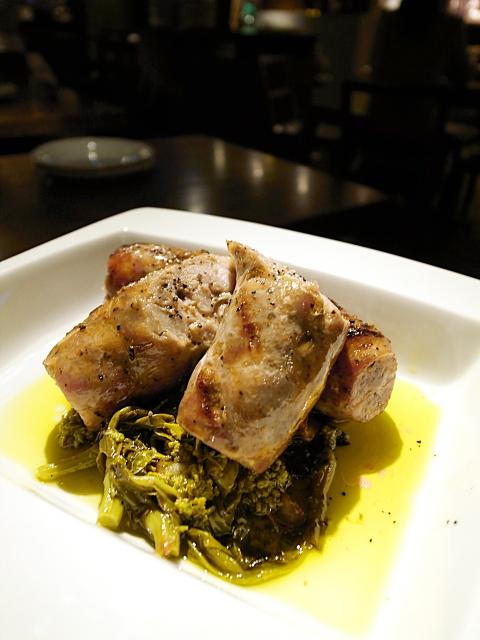
Photo: Ho Yi, Taipei Times
The romaine lettuce and egg salad (NT$320), on the other hand, was small and didn’t impress with the mushy vegetables.
Then comes the evening highlight: D.O.C (NT$700), Cuomo’s rendition of Neapolitan pizza that won top award at the Pizzafest, a world pizza championship held in Naples. With simple offerings of cherry tomato, basil and buffalo mozzarella, the pie makes simplicity tasteful, with the thin crust baked to a slightly crispy brown on the rim, while maintaining a satisfyingly buttery and chewy texture toward the center. But if diners don’t dive into the pizza right away, the crust tends to get soggy and can barely hold the toppings.
We also tried both the prosciutto and rucola (NT$750), topped with tomato sauce, buffalo mozzarella, smoked cheese, prosciutto ham, rocket greens and Parmesan, and bismark (NT$600), which comes with bacon, ham, spinach, mushrooms, semi-cooked egg and buffalo mozzarella. Both were good, but had the same problem of the soggy crust.
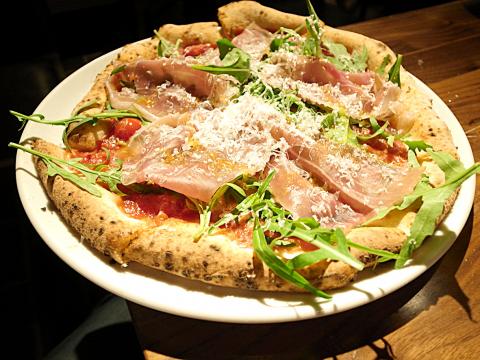
Photo: Ho Yi, Taipei Times
For pasta, we ordered the linguine aglio olio with swordfish and cabbage (NT$470), which my dining companions agreed was a bit too salty. Gnocchi and risotto are also on offer, while dishes like Neapolitan soup of seasonal seafood and fresh fish (NT$1,100) completes the restaurants’ southern Italian flavors.
To round off a hearty meal at Salvatore Cuomo & Bar, diners have several sweet options including tea-flavored panna cotta with fresh fruit sauce (NT$220), tiramisu (NT$220) and organic milk gelato topped with rich espresso sauce (NT$250).
Tipplers will be happy to know that Salvatore Cuomo & Bar has an extensive wine list made up of sparkling, white and red wines from Italy, France, German, Spain, Chile, Australia, New Zealand and the US (NT$230 to NT$280 by glass, NT$880 to NT$5,380 by bottle), along with a selection of beer and cocktails.
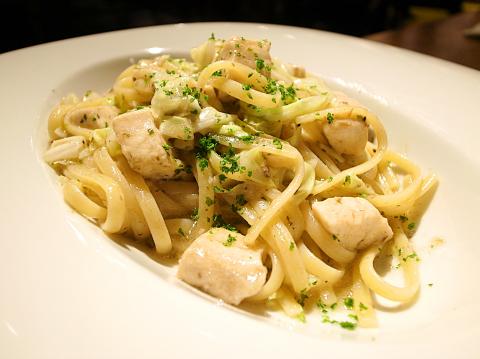
Photo: Ho Yi, Taipei Times
While the ambience of the restaurant is convivial for drinkers, one of my dining partners rightfully complained that the music played on the evening we visited was too loud and clubby, making it difficult for customers to relax and enjoy the food.
The restaurant offers lunch buffet that costs NT$500 on weekdays and NT$600 on weekends per head, plus 10 percent service charge. Only a la carte menu is available in the evening.
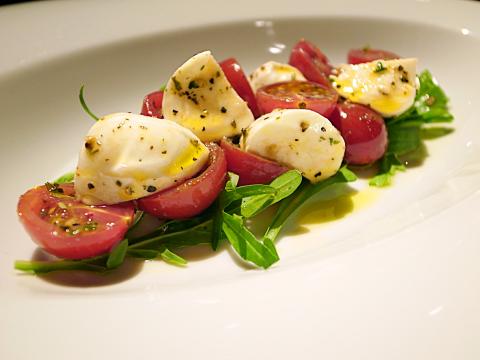
Photo: Ho Yi, Taipei Times
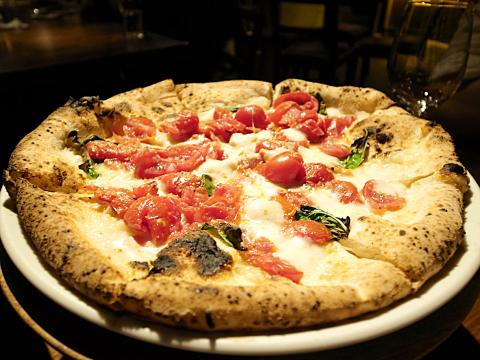
Photo: Ho Yi, Taipei Times

April 14 to April 20 In March 1947, Sising Katadrepan urged the government to drop the “high mountain people” (高山族) designation for Indigenous Taiwanese and refer to them as “Taiwan people” (台灣族). He considered the term derogatory, arguing that it made them sound like animals. The Taiwan Provincial Government agreed to stop using the term, stating that Indigenous Taiwanese suffered all sorts of discrimination and oppression under the Japanese and were forced to live in the mountains as outsiders to society. Now, under the new regime, they would be seen as equals, thus they should be henceforth

Last week, the the National Immigration Agency (NIA) told the legislature that more than 10,000 naturalized Taiwanese citizens from the People’s Republic of China (PRC) risked having their citizenship revoked if they failed to provide proof that they had renounced their Chinese household registration within the next three months. Renunciation is required under the Act Governing Relations Between the People of the Taiwan Area and the Mainland Area (臺灣地區與大陸地區人民關係條例), as amended in 2004, though it was only a legal requirement after 2000. Prior to that, it had been only an administrative requirement since the Nationality Act (國籍法) was established in

Three big changes have transformed the landscape of Taiwan’s local patronage factions: Increasing Democratic Progressive Party (DPP) involvement, rising new factions and the Chinese Nationalist Party’s (KMT) significantly weakened control. GREEN FACTIONS It is said that “south of the Zhuoshui River (濁水溪), there is no blue-green divide,” meaning that from Yunlin County south there is no difference between KMT and DPP politicians. This is not always true, but there is more than a grain of truth to it. Traditionally, DPP factions are viewed as national entities, with their primary function to secure plum positions in the party and government. This is not unusual

US President Donald Trump’s bid to take back control of the Panama Canal has put his counterpart Jose Raul Mulino in a difficult position and revived fears in the Central American country that US military bases will return. After Trump vowed to reclaim the interoceanic waterway from Chinese influence, US Defense Secretary Pete Hegseth signed an agreement with the Mulino administration last week for the US to deploy troops in areas adjacent to the canal. For more than two decades, after handing over control of the strategically vital waterway to Panama in 1999 and dismantling the bases that protected it, Washington has